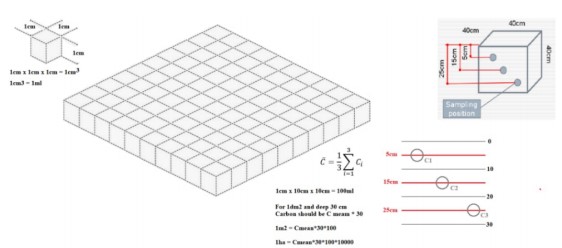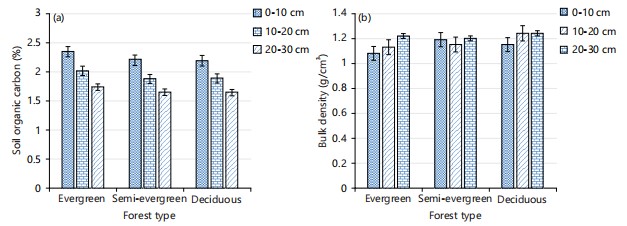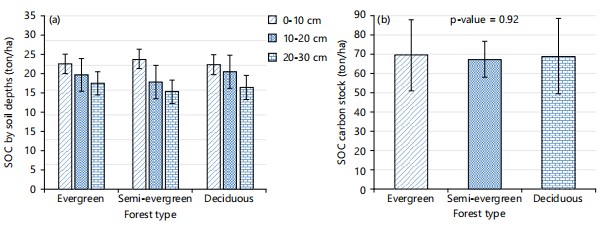Assessment of Soil Carbon Stock and Properties in Different Forest Types of Veun Sai-Siem Pang National Park, Cambodia
| Received 27 Mar, 2025 |
Accepted 02 Jul, 2025 |
Published 30 Sep, 2025 |
Background and Objective: Soil properties play a key role in ecosystem processes and carbon sequestration, but their variation by forest type and depth has not been explored in Cambodia. This study aimed to analyze key soil properties, such as nitrogen (N (%)), pH, organic matter (OM (%)), organic carbon (SOC (%)), and exchangeable hydrogen (H meq/g) in three forest types: Evergreen, semi-evergreen, and deciduous forests. Materials and Methods: Soil samples were collected from three depth intervals (0-10, 10-20, and 20-30 cm) by forest type. Standard laboratory methods were used to determine soil properties, including SOC and OM content, bulk density, and exchangeable hydrogen. Descriptive stats, ANOVA, and Pearson’s correlation (p<0.05) were performed in Excel and R to analyze soil properties. Results: Evergreen forests showed the highest OM (4.0% at 0-10 cm) and SOC (2.35% at 0-10 cm), resulting in lower pH (4.80) and more acidic soils with the highest exchangeable hydrogen (23.57 meq/g). Across all forest types, OM and SOC decreased with depth, reaching the lowest SOC values at 20-30 cm (evergreen: 1.74%, semi-evergreen: 1.65%, deciduous: 1.64%). Bulk density increased with depth, with the lowest values observed in evergreen forests (1.08 g/cm3 at 0-10 cm), indicating better soil structure and porosity. Soil carbon stocks were highest in the 0-10 cm layer (semi-evergreen: 26.07 Mg/ha) and declined at 20-30 cm (semi-evergreen: 19.59 mg/ha). Conclusion: The study revealed a significant effect of forest type and soil depth on soil carbon storage and nutrient accumulation. High SOC and OM in evergreen forests contribute to improved soil quality but also increase soil acidity. These findings provide important insights for sustainable forest management and climate change mitigation efforts, emphasizing the importance of maintaining soil carbon stocks in forest ecosystems.
| Copyright © 2025 Sarun et al. This is an open-access article distributed under the Creative Commons Attribution License, which permits unrestricted use, distribution, and reproduction in any medium, provided the original work is properly cited. |
INTRODUCTION
Soils play a fundamental role in forest ecosystems, acting as the primary reservoir for organic carbon, nutrients, and microbial activity. Among these functions, soil carbon storage is particularly critical in regulating the global carbon cycle, influencing atmospheric CO2 levels, and contributing to climate change mitigation1,2. Forest soils serve as significant carbon sinks, with their sequestration capacity varying across forest types due to differences in organic input, decomposition rates, and environmental conditions3,4. Understanding these variations is essential for developing sustainable forest management practices and enhancing carbon storage potential5,6. In Cambodia, forest ecosystems play a significant role in biodiversity conservation, climate regulation, and local livelihoods7. Veun Sai-Siem Pang National Park, located in Northeastern Cambodia, contains a diverse range of forest types, including evergreen, semi-evergreen, and deciduous forests, each exhibiting distinct ecological characteristics8. Evergreen forests are characterized by year-round biomass production, resulting in continuous organic matter input and high carbon sequestration potential9. Semi-evergreen forests experience seasonal changes but maintain high canopy cover, while deciduous forests are seasonally harvested, which influences the rate of organic matter decomposition and fertility10. The interactions between these factors directly affect soil properties, including nitrogen content (N%), soil pH, organic matter (OM%), soil organic carbon (SOC%), bulk density, and exchangeable hydrogen (H meq/g)11. Several studies have shown that SOC and OM content are highest in the top soil (0-10 cm), where organic matter from litterfall and root activity is most concentrated12. However, variations in soil depth and forest type influence soil carbon distribution and biogenesis, with deeper soil layers typically exhibiting lower SOC and OM due to reduced organic matter inputs and microbial activity13. In addition, soil acidity and bulk density play important roles in nutrient availability and carbon storage capacity, affecting plant growth and ecosystem stability14. In tropical forests, acidic soils are common due to heavy rainfall and organic matter decomposition, which releases basic pollutants and increases hydrogen ion concentrations15,16. Despite the ecological importance of Cambodian forests, there have been limited studies assessing soil carbon stocks and soil properties associated with different forest types in Voen Sai-Siem Pang National Park. Understanding how soil organic carbon (SOC) and other soil properties vary across ecosystems and depths is crucial for climate change mitigation, forest conservation, and land-use planning. This study aims to fill this knowledge gap by assessing SOC stocks in evergreen, semi-evergreen, and deciduous forests at various soil depths, examining variations in key soil properties such as bulk density, nitrogen content, organic matter, soil acidity, and exchangeable hydrogen, and soil carbon stock in different forest types. By providing insights into soil carbon dynamics and fertility across different forest types, this study will contribute to a deeper understanding of tropical forest ecosystems in Cambodia. The findings will be valuable for forest conservation efforts, carbon sequestration projects, and sustainable forest management strategies aimed at mitigating the impacts of climate change.
MATERIALS AND METHODS
Study area: The study was conducted in the Veun Sai-Siem Pang National Park, located in Northeastern Cambodia. The park’s boundaries are 57,469 ha17, have now expanded to a total of 280,359 ha, incorporating the biodiversity corridor area. Veun Sai-Siem Pang National Park is a critical region for biodiversity conservation, supporting community livelihoods and ecotourism in Cambodia18. The area experiences a tropical monsoon climate characterized by distinct wet and dry seasons. Annual rainfall in the region ranges from 1,500 to 2,000 mm, with temperatures fluctuating between 18 and 35°C. The dominant soil types in the study area are Acrisols and Ferralsols, typical of tropical forests characterized by high rates of weathering and leaching19.
A systematic random sampling approach was employed to collect soil samples from three forest types: Evergreen forest, semi-evergreen forest, and deciduous forest. Within each forest type, circular plots (radius = 21.85 m) were established. In each plot, soil samples were collected at three depth intervals: 0-10 cm (topsoil layer), 10-20 cm (subsurface layer), and 20-30 cm (deep layer). A total of 44 soil samples were collected using a cylindrical pit (2.5 cm diameter). The sampling site within each plot was located 65 m to the north of the plot’s starting point. A 100 mL sample was collected at each of the 5, 15, and 25 cm depths (Fig. 1). This depth range was chosen because soil carbon content typically decreases with depth. Collecting samples from only shallow soil layers, which contain higher amounts of organic matter, may lead to an overestimation of soil carbon content20. Each composite sample was derived from three sub-samples taken within the plot to ensure adequate representation. Samples were placed in polyethylene bags, labeled, and transported to the laboratory for further analysis.

|
Soil physicochemical analysis
Soil organic carbon (SOC (%)) and organic matter (OM (%)): The SOC was determined using the Walkley-Black method21, a wet oxidation technique that measures oxidizable organic carbon. Organic matter content (OM) was calculated by multiplying the SOC value by a conversion factor of 1.724, based on the assumption that organic matter contains approximately 58% carbon. The formula for calculating OM is:
Bulk density (g/cm3): Bulk density was determined using the core method22, where undisturbed soil samples were collected in metal cores, oven-dried at 105°C for 24 hrs, and weighed. Bulk density was calculated using the formula:
Soil carbon stock (Mg C/ha): Soil carbon stock was estimated using the following equation23:
Soil carbon stock (Mg C/ha) = SOC (%)×Bulk density (g/cm3)×Soil depth (cm) |
where, SOC (%) is the soil organic carbon percentage, bulk density (g/cm3) is the dry mass of the soil per unit volume, and soil depth (cm) represents the sampling depth.
Statistical analysis: Descriptive statistics, including mean, standard deviation, and coefficient of variation (CV (%)), were used to summarize soil properties across forest types and depths. One-way ANOVA tests were conducted to assess significant differences among forest types and soil depths. Pearson’s correlation analysis was performed to evaluate relationships between SOC and other soil properties. All statistical analyses were conducted using Excel and R Studio, with significance set at p<0.05.
RESULTS
Soil properties across different forest types: Table 1 illustrates the descriptive statistics for key soil properties across three forest types: Evergreen forest, semi-evergreen forest, and deciduous Forest. The analyzed soil parameters include nitrogen (N (%)), pH, organic matter (OM (%)), soil organic carbon (SOC,%), and exchangeable hydrogen (H (meq/g)). The mean nitrogen content is relatively similar across the three forest types, ranging from 0.18% in semi-evergreen forest to 0.20% in evergreen forest. However, the coefficient of variation (CV) reveals that evergreen forest exhibits the highest variability (25.00%), while semi-evergreen Forest shows the lowest (16.67%). Organic matter and soil organic carbon follow a similar trend, with slightly higher mean values in evergreen forests compared to the other two forest types. The variation in organic matter is highest in deciduous forest (CV = 22.87%), indicating a more heterogeneous distribution of organic matter in this ecosystem. In terms of soil pH, deciduous forest soils exhibit the highest acidity (mean pH = 5.46), whereas evergreen forest soils have the lowest pH (mean = 4.80), indicating more acidic conditions in the evergreen forest. This is consistent with the higher organic matter content observed in evergreen forests, which can contribute to increased acidification. The exchangeable hydrogen values are highest in evergreen forest (23.57 meq/g), followed by semi-evergreen forest (18.50 meq/g) and deciduous forest (10.89 meq/g). However, the CV for exchangeable hydrogen is greatest in deciduous forest (77.32%), suggesting that the acid-buffering capacity of the soil varies considerably across sampling sites. These findings have important implications for soil fertility and forest management. The higher organic matter and exchangeable hydrogen in evergreen forests result in more acidic soil conditions, which suggests higher decomposition rates but also potential nutrient leaching that could affect soil fertility. In contrast, semi-evergreen and deciduous forests, with higher pH values and lower exchangeable hydrogen, may have more stable soil conditions and less acidification over time. The high CV values for pH and exchangeable hydrogen in deciduous forest suggest significant spatial variation in soil acidity, which could be due to microhabitat differences, disturbances, or variations in organic input from leaf litter.
Soil organic carbon (SOC) and bulk density across different forest types and soil depths: Figure 2(a-b) illustrate the variation in soil organic carbon (SOC) content across different forest types and soil depths. In all three forest types evergreen, semi-evergreen, and deciduous-SOC was highest in the topsoil (0-10 cm) and gradually decreased with depth. The 0-10 cm layer contained the highest SOC percentage, with values of 2.35% in evergreen forests, 2.20% in semi-evergreen forests, and 2.19% in deciduous forests. A decline in SOC was observed in the 10-20 cm layer, where the SOC percentage decreased to 2.02, 1.88, and 1.89% for evergreen, semi-evergreen, and deciduous forests, respectively. The lowest SOC values were found in the 20-30 cm layer, with evergreen forests at 1.74%, semi-evergreen forests at 1.65%, and deciduous forests at 1.64%. This decline with increasing depth follows an expected pattern, as organic matter accumulation primarily occurs in the upper soil layers due to leaf litter decomposition, root activity, and microbial processes. Among the forest types, evergreen forests exhibited the highest SOC percentages across all depth layers, indicating a greater capacity for organic matter accumulation compared to semi-evergreen and deciduous forests. While semi-evergreen and deciduous forests had similar SOC values, the decrease in SOC with depth was more pronounced in these two forest types than in evergreen forests. The error bars indicate some variability in SOC measurements, but the overall trend remains consistent. The higher SOC content in the upper soil layers has important ecological implications. Increased SOC in topsoil enhances soil fertility, moisture retention, and microbial activity, all of which are essential for maintaining soil health and forest productivity. The greater SOC accumulation in evergreen forests suggests a stronger potential for carbon sequestration, highlighting their importance in climate change mitigation efforts. The observed decline in SOC with depth underscores the surface-based nature of soil carbon storage in forest ecosystems, emphasizing the need for sustainable land management practices to prevent carbon loss and maintain soil quality.

|
| Table 1: | Descriptive statistics of soil parameters of different forest types in Veun Sai-siem Pang National Park | |||
| Forest types | Descriptive statistic | N (%) | pH | OM (%) | SOC (%) | H (me/g) |
| Evergreen forest | Mean | 0.2 | 4.8 | 3.5 | 2.04 | 23.57 |
| Minimum | 0.12 | 4.2 | 2.01 | 1.17 | 10.9 | |
| Maximum | 0.29 | 5.42 | 5.06 | 3 | 55.4 | |
| SD | 0.05 | 0.29 | 0.72 | 0.42 | 9.22 | |
| CV (%) | 25 | 6.04 | 20.57 | 20.59 | 39.12 | |
| Semi-evergreen forest | Mean | 0.18 | 4.86 | 3.17 | 1.84 | 18.5 |
| Minimum | 0.11 | 4.12 | 1.87 | 1.09 | 2.7 | |
| Maximum | 0.25 | 5.73 | 4.73 | 2.75 | 42.75 | |
| SD | 0.03 | 0.4 | 0.58 | 0.35 | 8.33 | |
| CV (%) | 16.67 | 8.23 | 18.3 | 19.02 | 45.03 | |
| Deciduous forest | Mean | 0.19 | 5.46 | 3.28 | 1.91 | 10.89 |
| Minimum | 0.11 | 4.23 | 1.87 | 1.09 | 3.65 | |
| Maximum | 0.28 | 6.8 | 5.45 | 3.13 | 37.55 | |
| SD | 0.04 | 0.55 | 0.75 | 0.42 | 8.42 | |
| CV (%) | 21.05 | 10.07 | 22.87 | 21.99 | 77.32 |
The graph illustrates bulk density (g/cm3) across three forest types evergreen, semi-evergreen, and deciduous at three soil depths (0-10, 10-20, and 20-30 cm). Bulk density is a key soil property influencing porosity, water retention, and root penetration. The error bars represent the variability in measurements. Bulk density increases with depth across all forest types, with the lowest values observed in the 0-10 cm layer and higher values at deeper layers (10-20 and 20-30 cm). This trend is expected as surface soils typically have more organic matter and porosity, leading to lower density, while deeper layers consist of more compacted mineral particles with less organic content. In terms of forest type, Evergreen forests consistently exhibit the lowest bulk density at all depths, with a value of 1.08 g/cm3 in the 0-10 cm layer, which increases slightly in deeper layers. This suggests higher organic matter content, which helps reduce soil compaction. Semi-evergreen forests show the highest bulk density (1.19 g/cm3 in the 0-10 cm layer), indicating relatively more compact soil compared to evergreen forests. Deciduous forests have an intermediate bulk density (1.15 g/cm3 in the 0-10 cm layer), which is slightly higher than evergreen forests but lower than semi-evergreen forests. The implications of these findings for soil quality and carbon storage are significant. The lower bulk density in evergreen forests suggests better soil structure, higher porosity, and better support for root growth and water infiltration. Conversely, the higher bulk density in semi-evergreen and deciduous forests may indicate greater soil compaction, which could affect root penetration and hinder water movement. The increase in bulk density with depth also suggests that deeper layers are more compact, making them less favorable for organic matter accumulation and biological activity.

|
Soil carbon stock (ton/ha) across different forest types and soil depths: Figure 3a-b presents the distribution of soil carbon stock across three forest types evergreen, semi-evergreen, and deciduous at different soil depths (0-10, 10-20, and 20-30 cm). In all three forest types, the highest carbon stock was observed in the 0-10 cm layer, with semi-evergreen forests having the highest value (26.07 Mg C/ha), followed by evergreen (25.18 Mg C/ha) and deciduous forests (25.00 Mg C/ha). A decline in carbon stock was observed in the 10-20 cm layer, where values decreased to 22.94 Mg C/ha in evergreen forests, 21.57 Mg C/ha in semi-evergreen forests, and 23.60 Mg C/ha in deciduous forests. The lowest carbon stock values were found in the 20-30 cm layer, with evergreen, semi-evergreen, and deciduous forests storing 21.26, 19.59, and 20.39 Mg C/ha, respectively. This decreasing trend in carbon stock with depth indicates that most soil organic carbon is concentrated in the upper layers, which aligns with expected patterns due to organic matter decomposition and root activity. Among the forest types, semi-evergreen forests exhibited the highest carbon stock in the topsoil but also showed the sharpest decline with increasing depth. In contrast, evergreen and deciduous forests displayed a more stable distribution of carbon stock across depths. The total carbon stock across the 0-30 cm profile was relatively similar among forest types, with evergreen forests storing 69.38 Mg C/ha, semi-evergreen forests 67.23 Mg C/ha (the lowest), and deciduous forests 68.99 Mg C/ha. These findings underscore the importance of topsoil conservation, as it holds the majority of stored carbon. The sharp decline in carbon stock in semi-evergreen forests suggests that they may be more sensitive to disturbances, which could accelerate carbon loss in deeper layers. Understanding these variations in soil carbon storage is crucial for forest management and climate change mitigation strategies, particularly for optimizing carbon sequestration efforts.
DISCUSSION
This study provides a comprehensive analysis of soil carbon stock and key soil properties across three forest types evergreen, semi-evergreen, and deciduous in the Veun Sai-Siem Pang National Park, Cambodia. The findings revealed significant variations in soil properties, particularly in soil organic carbon (SOC), organic matter (OM), pH, bulk density, and nitrogen content, which are crucial for understanding forest ecosystem health, soil fertility, and carbon storage potential. The results were compared with previous studies to assess similarities and differences in soil characteristics across different forest ecosystems.
The highest levels of SOC and OM were observed in the topsoil (0-10 cm) for all forest types, consistent with previous findings24, which reported that forest soils tend to have higher organic matter accumulation in surface layers due to leaf litter deposition and microbial activity. However, the variation in SOC among forest types differs from the study by Rodrigues et al.25, which found higher SOC levels in deciduous forests compared to evergreen forests in India. In contrast, our study showed that evergreen forests had the highest SOC (2.35%) and OM content in the 0-10 cm layer, likely due to continuous biomass input from evergreen species, which supports long-term carbon sequestration. The lower SOC and OM in deciduous forests could be explained by the rapid decomposition of leaf litter during the dry season, which aligns with the findings of Gao et al.26. The observed decrease in SOC with depth across all forest types corresponds with Gross and Harrison27, confirming the general trend of organic carbon decline with increasing soil depth due to reduced biological activity and organic matter input in deeper layers.
Soil pH varied significantly among forest types, with deciduous forests having the highest pH (5.46) and evergreen forests exhibiting the lowest pH (4.80). The acidic nature of evergreen forest soils is in agreement with Kan et al.28, who suggested that high organic matter accumulation leads to organic acid production, contributing to lower soil pH. The negative correlation between pH and exchangeable hydrogen (H) ions observed in this study further supports this mechanism. However, compared to Ito et al.29, who reported pH (H2O) values ranging from 4.44 to 4.81 at depths up to 30 cm below the surface in evergreen forests, Cambodia. The more neutral pH in deciduous forests aligns with findings by other studies, suggesting that lower organic matter levels and slower decomposition rates contribute to reduced acidification.
Bulk density increased with depth across all forest types, a pattern that aligns with Schlesinger30, who noted that compaction is typically greater in deeper soil layers due to overlying pressure. However, the variation in bulk density among forest types shows some differences from previous research. Evergreen forests consistently had the lowest bulk density (1.08 g/cm3 in the 0-10 cm layer), which suggests better soil structure due to higher organic matter content, enhancing porosity and water retention. This result is consistent with findings by Jarvis and Leverenz31. In contrast, semi-evergreen forests exhibited the highest bulk density (1.19 g/cm3), differing from studies in similar ecosystems where deciduous forests often had the highest bulk density28. This discrepancy could be due to variations in soil texture and land-use history, which may influence compaction and porosity.
The highest soil carbon stock was observed in semi-evergreen forests, with 26.07 Mg/ha in the 0-10 cm layer. This result contrasts with findings by Jobbágy and Jackson3, who reported that evergreen forests generally store more carbon due to year-round litterfall. However, our results indicate that while evergreen forests retain high SOC levels, Semi-evergreen forests may accumulate more carbon due to specific site conditions, such as differences in biomass turnover rates and microbial activity. The sharp decline in carbon stock with depth in Semi-evergreen forests suggests that these forests may be more vulnerable to disturbances, similar to trends reported by Don et al.10. In contrast, the more stable carbon distribution in evergreen and deciduous forests suggests greater resilience to environmental changes, aligning with observations by Lal32.
CONCLUSION
This study examined soil carbon stock and key soil properties across three forest types, such as evergreen, semi-evergreen, and deciduous, in Veun Sai-Siem Pang National Park, Cambodia. The results demonstrated that soil organic carbon (SOC) and organic matter (OM) were highest in the topsoil and decreased with depth. Evergreen forests exhibited the highest SOC (2.35% at 0-10 cm), followed by semi-evergreen and deciduous forests. Soil pH and exchangeable hydrogen (H) varied across the forest types, with evergreen forests being more acidic. Bulk density increased with depth, with evergreen forests showing the lowest bulk density. Soil carbon stock followed a similar trend, with the highest values in the topsoil. Total carbon stock across the 0-30 cm depth ranged from 67.23 mg/ha (Semi-evergreen) to 69.38 mg/ha (Evergreen). These findings underscore the importance of sustainable forest management practices to protect soil fertility and enhance carbon sequestration potential.
SIGNIFICANCE STATEMENT
This study assesses soil carbon stocks and Soil properties across different forest types in Veun Sai-Siem Pang National Park, Cambodia. Understanding soil carbon dynamics is important for carbon sequestration, climate change mitigation, and sustainable forest management. By analyzing variations in soil carbon content among different forest ecosystems, the findings provide insight into the role of forests in carbon storage and their potential contribution to REDD+ initiatives. The study supports evidence-based conservation policies, emphasizing the importance of protecting forests in maintaining soil health and reducing carbon emissions.
ACKNOWLEDGMENTS
This study was financially supported by the Research Team of the Royal University of Agriculture. The authors would like to express their sincere gratitude to the editors and expert reviewers of the Trends in Environmental Sciences for their valuable feedback and suggestions to improve this manuscript.
REFERENCES
- Grace, J., 2004. Understanding and managing the global carbon cycle. J. Ecol., 92: 189-202.
- Lal, R., 2004. Soil carbon sequestration to mitigate climate change. Geoderma, 123: 1-22.
- Jobbágy, E.G. and R.B. Jackson, 2000. The vertical distribution of soil organic carbon and its relation to climate and vegetation. Ecol. Appl., 10: 423-436.
- Pan, Y., R.A. Birdsey, J. Fang, R. Houghton and P.E. Kauppi et al., 2011. A large and persistent carbon sink in the world’s forests. Science, 333: 988-993.
- Jepma, C.J., S. Nilsson, M. Amano, Y. Bonduki, L. Lönnstedt, J. Sathaye and T. Wilson, 1997. Carbon sequestration and sustainable forest management: Common aspects and assessment procedures. Crit. Rev. Environ. Sci. Technol., 27: 83-96.
- Kassaye, M., Y. Derebe, W. Kibrie, F. Debebe, E. Emiru, B. Gedamu and M. Tamir, 2024. The effects of environmental variability and forest management on natural forest carbon stock in Northwestern Ethiopia. Ecol. E, 14.
- Banerjee, O., M. Cicowiez, E.C. Honeck, M.S. Muthukumara and K.A. Stapleton, 2025. Investing in forests enhances ecosystem services and economic growth in Cambodia: Evidence from the integrated economic-environmental modelling (IEEM) approach. Ecosyst. Serv., 71.
- McGrath, S.J. and A.M. Behie, 2021. Hunting pressure on primates in Veun Sai-Siem Pang National Park, Cambodia. Int. J. Primatol., 42: 563-588.
- Tan, Z.H., Y.P. Zhang, D. Schaefer, G.R. Yu, N. Liang and Q.H. Song, 2011. An old-growth subtropical Asian evergreen forest as a large carbon sink. Atmos. Environ., 45: 1548-1554.
- Don, A., J. Schumacher and A. Freibauer, 2011. Impact of tropical land-use change on soil organic carbon stocks-A meta-analysis. Global Change Biol., 17: 1658-1670.
- Pignatello, J.J., M. Uchimiya and S. Abiven, 2024. Aging of Biochar in Soils and its Implications. 3rd Edn., Routledge, London, United Kingdom, ISBN: 9781003297673, Pages: 28.
- Post, W.M. and K.C. Kwon, 2000. Soil carbon sequestration and land-use change: Processes and potential. Global Change Biol., 6: 317-327.
- Li, H., L. Chang, H. Liu and Y. Li, 2024. Diverse factors influence the amounts of carbon input to soils via rhizodeposition in plants: A review. Sci. Total Environ., 948.
- Kandel, D., S. Timilsina, S. Ayer, S.K. Chaudhary, J. Gautam, R. Adhikari and K.P. Bhatta, 2024. Assessment of soil carbon stock and soil quality in different forest stands and management regimes in Terai Region of Nepal. Scientifica, 2024.
- Lugo A.E. and S. Brown, 1993. Management of tropical soils as sinks or sources of atmospheric carbon. Plant Soil, 149: 27-41.
- Zhao, S. and M. Riaz, 2024. Plant-Soil Interactions and Nutrient Cycling Dynamics in Tropical Rainforests. In: Environment, Climate, Plant and Vegetation Growth, Fahad, S., S. Saud, T. Nawaz, L. Gu, M. Ahmad and R. Zhou (Eds.), Springer, Cham, Switzerland, ISBN: 978-3-031-69417-2, pp: 229-264.
- McGrath, S.J., J. Liu, B.C. Stevenson and A.M. Behie, 2023. Density and population size estimates of the endangered Northern yellow-cheeked crested gibbon Nomascus annamensis in selectively logged Veun Sai-Siem Pang National Park in Cambodia using acoustic spatial capture-recapture methods. PLoS ONE, 18.
- Kibria, A.S.M.G., A. Behie, R. Costanza, C. Groves and T. Farrell, 2017. The value of ecosystem services obtained from the protected forest of Cambodia: The case of Veun Sai-Siem Pang National Park. Ecosyst. Serv., 26: 27-36.
- Schad, P., C. van Huyssteen and E. Michéli, 2014. World Reference Base for Soil Resources 2014: International Soil Classification System for Naming Soils and Creating Legends for Soil Maps. FAO, Rome, Italy, ISBN: 978-92-5-108370-3, Pages: 192.
- Takahashi, M., S. Ishizuka, S. Ugawa, Y. Sakai and H. Sakai et al., 2010. Carbon stock in litter, deadwood and soil in Japan's forest sector and its comparison with carbon stock in agricultural soils. Soil Sci. Plant Nutr., 56: 19-30.
- Walkley, A. and I.A. Black, 1934. An examination of the degtjareff method for determining soil organic matter, and a proposed modification of the chromic acid titration method. Soil Sci., 37: 29-38.
- Blake, G.R. and K.H. Hartge, 1986. Bulk Density. In: Methods of Soil Analysis: Part 1 Physical and Mineralogical Methods, Klute, A. (Ed.), Soil Science Society of America, American Society of Agronomy, ISBN: 9780891188643, pp: 363-375.
- Batjes, N.H., 1996. Total carbon and nitrogen in the soils of the world. Eur. J. Soil Sci., 47: 151-163.
- Bruun, T.B., B. Elberling, A. de Neergaard and J. Magid, 2015. Organic carbon dynamics in different soil types after conversion of forest to agriculture. Land Degrad. Dev., 26: 272-283.
- Rodrigues, C.I.D., L.M. Brito and L.J.R. Nunes, 2023. Soil carbon sequestration in the context of climate change mitigation: A review. Soil Syst., 7.
- Gao, C., L. Montoya, L. Xu, M. Madera and J. Hollingsworth et al., 2019. Strong succession in arbuscular mycorrhizal fungal communities. ISME J., 13: 214-226.
- Gross, C.D. and R.B. Harrison, 2019. The case for digging deeper: Soil organic carbon storage, dynamics, and controls in our changing world. Soil Syst., 3.
- Kan, Z.R., W.X. Liu, W.S. Liu, R. Lal, Y.P. Dang, X. Zhao and H.L. Zhang, 2022. Mechanisms of soil organic carbon stability and its response to no-till: A global synthesis and perspective. Global Change Biol., 28: 693-710.
- Ito, E., B. Tith, B. To and J. Nagakura, 2024. Physicochemical soil properties following selective cutting of large-diameter trees in a lowland dry evergreen forest in Cambodia. Japan Agric. Res. Q., 58: 215-232.
- Schlesinger, W.H., 1991. Biogeochemistry: An Analysis of Global Change. 2nd Edn., Elsevier, Amsterdam, Netherlands, ISBN: 978-0-12-625157-9, Pages: 441.
- Jarvis, P.G. and J.W. Leverenz, 1983. Productivity of Temperate, Deciduous and Evergreen Forests. In: Physiological Plant Ecology IV Ecosystem Processes: Mineral Cycling, Productivity and Man’s Influence, Lange, O.L., P.S. Nobel, C.B. Osmond and H. Ziegler (Eds.), Springer, Berlin, Heidelberg, ISBN: 978-3-642-68156-1 pp: 233–280.
- Lal, R., 2005. Forest soils and carbon sequestration. For. Ecol. Manage., 220: 242-258.
How to Cite this paper?
APA-7 Style
Sarun,
H., Lyhour,
H., Sophea,
N., Sopheak,
T., Soben,
K., Sokra,
I. (2025). Assessment of Soil Carbon Stock and Properties in Different Forest Types of Veun Sai-Siem Pang National Park, Cambodia. Trends in Environmental Sciences, 1(3), 261-269. https://doi.org/10.21124/tes.2025.261.269
ACS Style
Sarun,
H.; Lyhour,
H.; Sophea,
N.; Sopheak,
T.; Soben,
K.; Sokra,
I. Assessment of Soil Carbon Stock and Properties in Different Forest Types of Veun Sai-Siem Pang National Park, Cambodia. Trends Env. Sci 2025, 1, 261-269. https://doi.org/10.21124/tes.2025.261.269
AMA Style
Sarun
H, Lyhour
H, Sophea
N, Sopheak
T, Soben
K, Sokra
I. Assessment of Soil Carbon Stock and Properties in Different Forest Types of Veun Sai-Siem Pang National Park, Cambodia. Trends in Environmental Sciences. 2025; 1(3): 261-269. https://doi.org/10.21124/tes.2025.261.269
Chicago/Turabian Style
Sarun, Horn, Hin Lyhour, Nhean Sophea, Thav Sopheak, Kim Soben, and In Sokra.
2025. "Assessment of Soil Carbon Stock and Properties in Different Forest Types of Veun Sai-Siem Pang National Park, Cambodia" Trends in Environmental Sciences 1, no. 3: 261-269. https://doi.org/10.21124/tes.2025.261.269

This work is licensed under a Creative Commons Attribution 4.0 International License.




